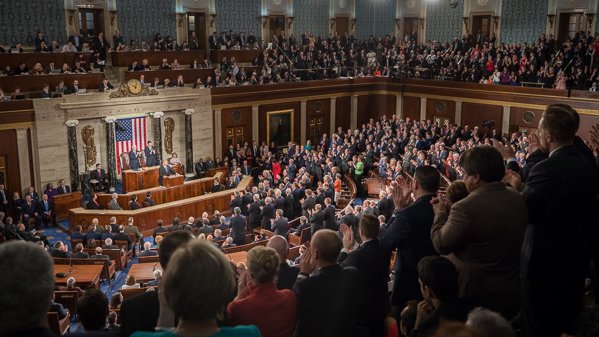Executive Agreements: International Lawmaking Without Accountability?
This post is cross-posted on Just Security.

Published by The Lawfare Institute
in Cooperation With

This post is cross-posted on Just Security.
In a post last month, we described the sharp decline in the presidential use of Article II treaties—reaching a new low in the Trump administration, which so far has submitted only one such treaty to the Senate. This decline does not mean that the United States has stopped concluding international agreements. In fact, the United States makes dozens of binding international agreements each year—often more than 100—but it usually does so as “congressional-executive agreements” (i.e., agreements authorized by statute) rather than as Article II treaties. The United States has thus effectively shifted to an administrative regime for making international agreements, but it has yet to craft an adequate system of oversight and accountability to go along with that regime.
One of us (Hathaway) has previously argued that the Article II process is outdated and that it is normatively better for agreements to be subjected to majority votes in both houses of Congress rather than a supermajority vote in the Senate. Importantly, however, that is not what is happening. “Ex post” congressional-executive agreements (those approved by Congress after negotiation) are extremely rare—even rarer that Article II treaties—and are mainly used for trade agreements. (The Trump administration’s proposed United States-Mexico-Canada Agreement which is designed to replace NAFTA, will go through this process.) Instead, almost all congressional-executive agreements are based on purported “ex ante” statutory authorization. These agreements are usually based on statutes enacted many years or even decades before the agreement, and they do not receive any meaningful after-the-fact review or approval by the legislature.
The Trump administration has continued this practice, as is evident from perusing the State Department’s online database, Texts of International Agreements to Which the U.S. is a Party (TIAS). This database is the only current public database that includes the text of such agreements, but it is far from complete. As the site itself notes, classified agreements are exempted from reporting. And the relevant reporting statute does not require publication even of all non-classified agreements. Keeping in mind that the precise numbers of agreements are difficult to discern, in the first year of the Trump administration, there were 104 agreements reported, according to the database. That is consistent with prior years (the average for the years in the database is 99 agreements per year). In 2018, however, there were only 39 agreements reported. It is hard to know whether that reflects a real decline, if the site is simply not up-to-date, or if a lower percentage of the agreements made have been reported through the database. (This uncertainty itself illustrates the inadequate transparency of the process.)
Ex ante congressional-executive agreements are akin to many administrative regulations in that they are often based on vague or broad statutory authorizations, and they are concluded by a variety of executive branch agencies. Some of the same concerns raised in the administrative regulation context—legality, interest group capture, imprudent or corrupt bureaucratic action, and the like—arise as well in the context of ex ante congressional-executive agreements. But there is at least one key difference: Administrative regulations are governed by a complex administrative law framework, but ex ante congressional-executive agreements are not governed by an administrative law or any other accountability framework beyond an incomplete and under-enforced reporting requirement.
Foreign affairs matters were expressly exempted from the Administrative Procedure Act. As a result, there is no notice-and-comment process for the making of ex ante congressional-executive agreements. Nor is there any statutorily-prescribed judicial review to ensure that the executive stays within the terms of the statutory delegations. And the reporting system that is currently in place (including in the TIAS, referred to above) is inadequate along a number of dimensions, as the three of us have explained in prior writings. Among other things, the reporting is incomplete and often untimely, it lumps Article II treaties and executive agreements together and fails to distinguish among the various types of executive agreements, and it fails to provide any account to the public of the legal authority that purportedly supports such agreements.
The Case Act, enacted in 1972, recognized that executive agreements were becoming the dominant means by which the executive concluded international agreements, and Congress opted for transparency in an effort to deter problematic conduct and allow for monitoring of potential policy and legal problems. The principal mechanism of the Case Act framework is the requirement that the executive branch report executive agreements to Congress within 60 days of concluding them. As one of us explained in a prior article, early on, this worked reasonably well—as most such delegations of authority were accompanied by legislative veto provisions that did not require presentment to the president. After the Supreme Court in INS v. Chadha found such vetoes unconstitutional, Congress responded by stripping the legislative vetoes from the statutes, leaving the bare delegations of authority in place. As a result, the mere requirement of disclosure did Congress little good: Even if it objected to an agreement, there was almost nothing Congress could do about it. (Repealing the agreement would likely require assembling veto-proof majorities in both houses, a near-impossible feat.)
One might think that even if Congress cannot repeal agreements, the disclosure to Congress required by the Case Act and the publication of agreements provide sufficient accountability. But there are reasons to think that is not true. To begin with, the State Department does an uneven job of collecting internally and disclosing to Congress and the public the information about agreements made by the United States. As we will explain more fully in a later post, the TIAS does not appear to be complete, nor were the earlier online Case Act reports provided by the State Department. In addition, the Brennan Center for Justice documented that there are large numbers of “secret” executive agreements—that is, agreements that are classified. And even when the agreements themselves are reported to the public, the legal basis is not. Pursuant to a regulation that took effect in 1981, when the executive branch reports its executive agreements to Congress, it provides a citation of the legal authorities that it believes allow it to conclude the agreement without seeking senatorial advice and consent. But while Congress is provided with that information, the public is not. The cover memos that accompany the Case Act reports are always stripped from the agreements before they are made public.
It is long past due for Congress to take a close look at the process for making international agreements. These agreements are essential to the effective functioning of the United States in the world, but they should be made in a way that allows the American people to understand the commitments made on their behalf. Despite the growth and developing nature of U.S. agreement-making processes, Congress has not seriously revisited the Case Act regime, and it has never sought to bring administrative rigor to the agreement-making process. It’s time for that to change.






.png?sfvrsn=48e6afb0_5)
